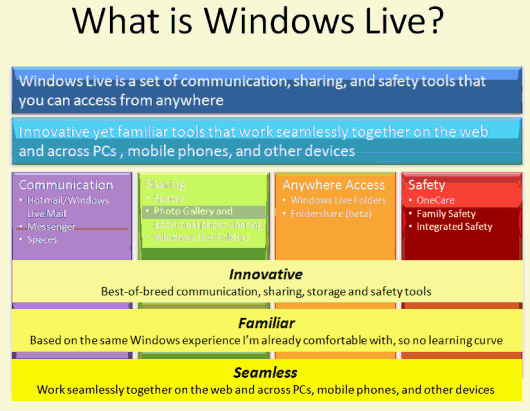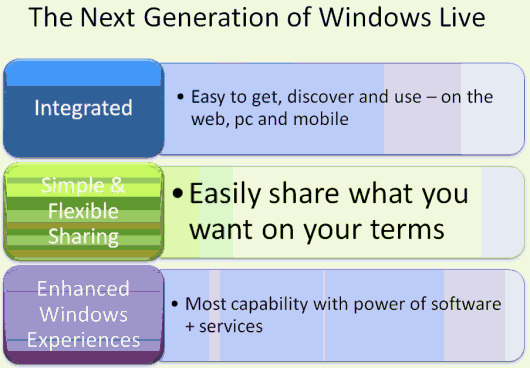Tonight Microsoft is launching two more products
into its suite of Windows Live branded consumer web
apps – Windows Live Photo Gallery Beta and Windows Live Folders Beta. According to
Microsoft, tonight also marks the beginning of the next stage of the Windows Live
rollout. This “next generation” of Windows Live has the goal of being a more cohesive
suite of products than in the first phase.

I spoke to Brian Hall, General Manager for Windows Live, this week to find out more
about Microsoft’s plans for Windows Live and how it is evolving.
The two new products are fairly typical web 2.0 products –
TechCrunch has a good write-up. But just quickly, Photo Gallery is a Flickr-like
photo sharing app with all the usual 2.0 bells and whistles (tags, sync between camera
and PC, etc). Windows Live Folders is an online storage app, with P2P and file sync
features. It is also, I discovered, a re-branding of LiveDrive.
In this post we’ll explore the notion that the “next generation” of Windows Live has
arrived. What does that mean exactly?
Windows Live Progress, Since November 05
The first stage of Windows Live, which began when Bill Gates announced
the Windows Live strategy in November 2005, has been marked by a lot of beta web
applications and ‘software as a service’ apps (hybrid desktop/browser apps). Windows Live
has not been a smooth rollout – in fact many of the products have been disjointed and confusingly
branded. Some products (e.g. the start page live.com) have also been very raw and the
strategy at times unclear.
Probably the most overriding impression of Windows Live over the past year or two has
been the branding confusion. And in particular widespread confusion about how Windows
Live overlaps with MSN. I asked Brian about the branding problems (see below), but first
let’s look at what Windows Live is aiming to become.
What is Windows Live, circa June 2007?
During my talk with Brian, the following slide was presented:
Source: Microsoft

You can see that the desktop/browser hybrid model is to the fore (the words ‘seamless’
and ‘integrated’ are used a lot nowadays).
In terms of the types of products represented under the umbrella Windows Live, they
are: Communication, Sharing, Anywhere Access, Safety. The first two (Communication,
Sharing) are very much typical web 2.0 consumer apps – email, social networking, photo
sharing, etc. These are the same apps that Google, Yahoo and others have. The other two
(Anywhere Access, Safety) are more the types of apps we traditionally expect from
Microsoft – but under Windows Live they are delivered as ‘software as a service’, to use
their term, rather than traditional shrink-wrap products.
Brian told me that the next generation of Windows Live will be “more cohesive” and
much more of a proper suite. As Nick at Techcrunch noted, this includes releasing all the
pieces of the Live Suite as a single upgradeable download – instead of separate programs
and services as they are now.
Here is the other slide that was presented to me, which shows some of Microsoft’s
other goals with Windows Live:
Source: Microsoft

The above 3 points all play to Microsoft’s strengths – multi platforms, leveraging
Windows, and using ‘software + services’ to provide web 2.0 capabilities like
sharing.
Brand Confusion Still Reigns
Returning now to the branding. I asked how far has Microsoft come in clarifying the
confusion between the new Windows Live brand and the existing MSN brand. Brian said this
will become more clear in the second generation of Windows Live; and that much of the
confusion arose in the first place because some MSN services have been transitioned
across to Windows Live – e.g. Hotmail was initially an MSN product, but now it is Windows
Live Mail (although Hotmail is still being used as part of the brand).
The Hotmail example clearly shows there is still a lot of work to do in the branding. But
Brian said that, broadly speaking, MSN = content and news, while Windows Live refers to
the 4 categories mentioned above (communication, sharing, anywhere access, safety).
It also doesn’t help that the product names continue to chop and change, or there is more than one product doing similar things. e.g.
LiveDrive has become Windows Live Folders. And then there is FolderShare, which Microsoft acquired in 2005.
So, still a lot of work to do on branding!
Conclusion: Cohesion Some Way Off
Brian emphasized that this is just the beginning of Stage 2 of Windows Live, and their overall aim is to make Windows Live more cohesive – while continuing to bring products out of beta and
refine the desktop/browser vision.
My impression is that Windows Live is still a fragmented vision, with a few too many
products. But this has been a common ailment amongst the big Internet companies in this
era of the Web. Yahoo famously brought out a Peanut
Butter manifesto to try and focus its product range. And even Google, which has
otherwise been the leader in bigco web apps, has had its problems – with too many
products, lack of integrated suites (e.g. in Web Office) and an at-times awful branding
(e.g. the original ‘Google Apps For Your Domain’).
But Microsoft has more of a challenge than Google or Yahoo, because it is
traditionally a desktop software company – whereas the other two are ‘Web native’.
Windows Live is coming along nicely, but there is a long way to go yet before it becomes
truly cohesive – and compelling.










